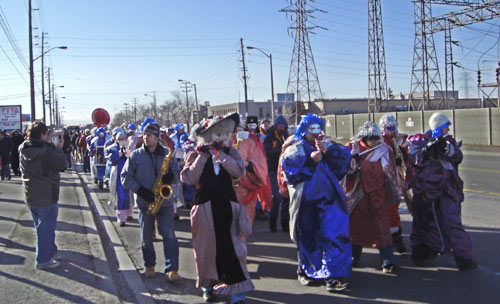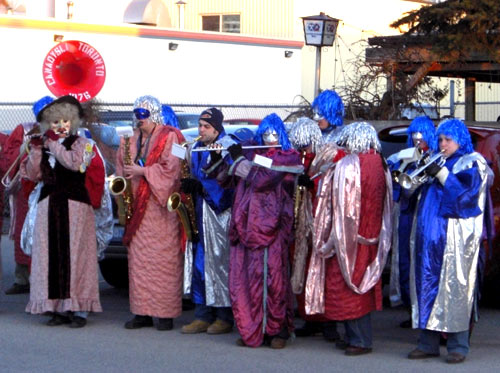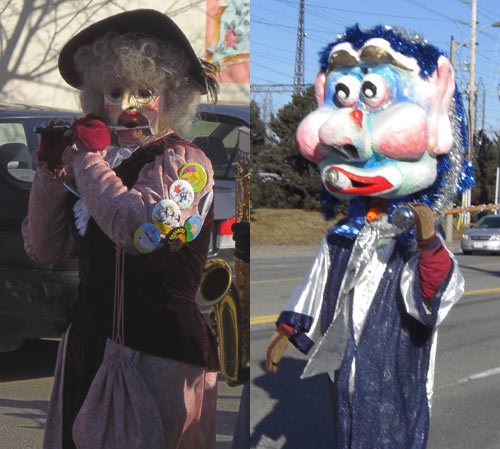
Carnival or Mardi Gras celebrations — the big party before the 40 days of fasting leading up to Easter in the Catholic Christian tradition — have been going strong for many centuries, and still take place in many European cities, as well as in Latin America and some islands in the Caribbean. Elaborate public carnival festivities first developed in Europe in the late Middle Ages, as cities became prosperous and well-organized. They involved parades through the main streets and squares of the city featuring groups in elaborate matching costumes, music, lights, floats, and often social and political satire, followed by feasting and dancing.
In Toronto, unfortunately, it’s generally very cold when Carnival time comes around, usually sometime in February. That’s why Caribana, which is inspired by Caribbean carnivals, happens in August. I had always assumed that meant there were no actual public carnival parades in Toronto, but recently, to my delight, I was talking to a friend whose father is Swiss, and she informed me that in fact the small Swiss community in Toronto has been holding an outdoor carnival parade every year since 1976.
For some reason that never became entirely clear to me, the Swiss hold their Carnival parade very early in the morning (as opposed to late in the evening like most places). The Toronto version used to take place in the dark at 4:00 am, as it does in Basel, Switzerland, but now it is done at 7:00 am — on a Saturday!
I was eager to see this event despite the discouraging time, so I agreed to be picked up by my friend at 6:00 in the morning on Saturday February 28th and driven out to The Musket, a German restaurant in a business park in Etobicoke that serves as the meeting place, headquarters, and refuge from the cold for “Morgestraich”, the Swiss carnival parade.
It was too cold to hold the whole parade at 7 that morning, because the instruments would freeze, so there was just a brief outdoor concert at that time, followed by an indoor concert.

The parade itself began at 9:30, led by the band with the band leader marching out front, circling a long block in the business park while playing a selection of rousing music to the steady beat of drums. It was funny to see startled motorists trying to figure out what was going on. There were about 25 people in the Canadysli Guggemusig band which is the heart of the parade, and I think about 100 spectators/followers.
The parade followed carnival traditions — the band members all in different sets of matching costumes (voluminous ones so that they could wear warm clothes underneath), and many with brightly painted instruments. Two in particular had real old-style carnival costumes — an old lady costume, with a crazy elaborate head of grey hair with a hat, and the band leader wearing a huge head.

Apparently, in earlier times most of the band in the Toronto parade had these elaborate giant heads, but the older band members are getting too old to carry these heavy headsets, and the community doesn’t have storage space for them anymore.
I was told that, in the tradition of medieval carnivals, the parade also used to have political satire in its early days — panels making fun of politicians — but these eventually became outdated and haven’t been replaced.
Before and after the parade, we gathered in the restaurant and ate traditional carnival foods that are only made that day of the year. Fasnacht cookies are huge thin cookies that have been deep-fried so that they are crispy and bubbly, and sprinkled with icing sugar — think big, sweet papadums. Delicious. There’s also a thick brown soup made with toasted flour, which can be kindly described as hearty and suitable for accompanying a cold day and beer-drinking. There was a also a cheese pie — like a quiche but mostly cheese — which I regret not trying.
As we ate the food, my friend’s family told me the story of Toronto’s Swiss carnival. A number of Swiss had immigrated to Canada in the late 60s and early 70s, and the carnival was a way for the community to get together. For many years, it was held in Yorkville, with the loud band waking up tourists and residents at 4 am one Saturday morning every year, before retiring to a Swiss-owned establishment in Yorkville for the post-parade celebration — and then another round of parading at 7 am! My friend recalled as a kid being roused out of bed incredibly early, putting on the elaborate costumes, playing the tambourine in the band. But, eventually, the City became reluctant to let this tourist/residential neighbourhood be disrupted in this way, and the event moved out to the business park in Etobicoke where it still takes place.

I loved this large, intricate brass instrument (a sousaphone, I think).
One curiosity is the date of this Swiss carnival — it happens the week after Mardi Gras, not beforehand like usual, so actually during Lent. This oddity might be explained by the fact that the Swiss carnival comes from a Protestant area, which technically doesn’t observe Lent, so the delay might be a way of distinguishing what is really just an excuse for a good mid-winter party from the usual Catholic connotations of Carnival. An alternative explanation has to do with conflicting calendar reforms.
The inspiration for the Toronto carnival parade is the big Morgestraich in Basel, Switzerland, which I was told takes place at 4:00 in the morning with the music reverberating through the narrow streets of the town, with many participants, elaborate costumes, and political satire.
While the Toronto one is of a much smaller scale, it was great to see that there are now quite a few younger people participating in the band or coming to watch — and not all of them are even Swiss. With any luck the modest but lively Swiss carnival will continue to enliven a winter morning on a little bit of Toronto’s streets for many years in the future.


4 comments
I am a Member of Canadysli and I enjoy every Minute of it.
Your Articel I find very good and hope a lot of People see it and pherhaps more People will enjoy it next Year.
Thank you for your effort to put it in the Paper.
A friendly fello from Eugen.
I too used to be part of the festivities, but sadly due to work I haven’t been able to go in several years. I loved being part of the parade, but loved the looks we would get from the locals!
I’m so glad you wrote about this little festival! And I’m sorry I didn’t make it to the march. I have so many fond memories of Morgestraich in Toronto. My dad used to play the big drum in the band and me and my brother would follow him around in bright costumes banging little tambourines and moraca shakers. I also really loved helping my dad and his Canadysli buddies make big elaborate papier mache masks. Those Yorkville years were the best! I’m glad it still lives on even if it’s in a hidden industrial zone of etobicoke.
It’s great to see your article about the Canadysli Guggemusig, I was one of the founding members and we sure had great times playing this kind of music with all sorts of instruments, and in the beginning I was playing a little drum which then had cost me a fortune, I think it was 35 dollars and I got it from a pawn shop. I mean, I could have taken a flying lesson for less than that, or buy a vacuum cleaner, but these things just had to wait as we also had to invest time in making costumes and masks.
Oh, it was such an adventure to do all these things shortly after immigrating from Switzerland, I had never really played music before in a group and it helped a lot forming friendships which I wouldn’t have had otherwise.
I would also like to say hello to those that remember me from the early days, I was the guy with the blinking eyes mask in the seventies and my sister and her husband playing trumpets.
So now, Canadyslians, keep good ole T.O. rockin’ !
Herb